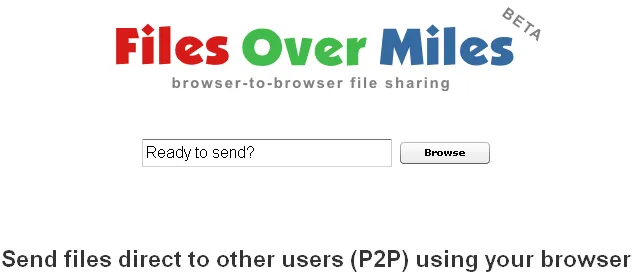Files Over Miles: The Ultimate Guide to Efficient File Sharing and Management

Introduction to Files Over Miles
In today’s interconnected world, the phrase “Files Over Miles” encapsulates the essential nature of efficient file sharing and management across distances. The rapid evolution of technology and the rise of remote work have underscored the increasing importance of seamless collaboration regardless of geographic locations. However, traditional methods of file sharing often struggle to meet the dynamic needs of users, leading to unnecessary delays and communication challenges that can stifle productivity.
The significance of effective file management cannot be overstated in a landscape where teams are dispersed globally. Physical boundaries no longer define workplace collaboration; instead, digital platforms that facilitate the instant transfer of files are paramount. As organizations strive to maximize their operational efficiency, the challenges of distance—often manifested as slow data transfer rates and cumbersome communication practices—become more apparent.
To address these challenges, innovative solutions that provide robust and efficient file sharing mechanisms are essential. File sharing platforms, cloud storage solutions, and collaborative tools have emerged as vital resources, enabling users to access, share, and manage files effortlessly across miles. This shift facilitates real-time collaboration and access to critical information, ensuring that all team members can stay engaged and informed, regardless of their physical whereabouts.
The transition to “Files Over Miles” exemplifies the need for adaptive strategies that not only enhance productivity but also foster a sense of teamwork among remote collaborators. As organizations continue to navigate the complexities of modern work environments, embracing effective file sharing and management tools will be crucial to overcoming geographical barriers and achieving collective success.
Understanding File Sharing Technologies
In today’s globalized world, the ability to share files efficiently across vast distances is vital for both personal and professional settings. Various technologies cater to this need, with each offering unique advantages and disadvantages. Understanding these options can enhance file sharing processes and improve productivity.
One of the most widely adopted technologies is cloud storage. Cloud platforms enable users to upload, store, and share files over the internet, which allows for easy access from any device equipped with internet connectivity. Services such as Google Drive, Dropbox, and OneDrive illustrate how cloud storage empowers individuals and businesses to operate virtually. The advantages of cloud storage include scalability, collaboration features, and automatic backups. However, users might also face concerns related to data security, privacy, and potential dependency on internet access.
Another significant method for transferring files over longer distances is through file transfer protocols (FTP). FTP is a standard network protocol that allows for the transfer of files from one host to another via a TCP-based network. This technology is particularly advantageous for transferring large volumes of data because it is efficient and generally secure when used in conjunction with encryption methods. However, FTP can be challenging for less technically adept users and may require specific software for seamless operation.
Lastly, peer-to-peer (P2P) sharing presents an alternative approach to file sharing without relying on centralized servers. This method enables users to share files directly with one another, which can reduce the load on servers and improve transfer speeds. Popularized by applications such as BitTorrent, P2P sharing is efficient and cost-effective; however, users should exercise caution regarding copyright issues and the potential for file-sharing security risks.
Ultimately, the choice of file sharing technology depends on individual or organizational needs and preferences. Each method presents advantages and drawbacks, thus requiring careful consideration to optimize file exchanges effectively.
Choosing the Right File Sharing Solution
Selecting an appropriate file sharing solution is paramount for effective communication and collaboration, especially as businesses increasingly rely on remote work and digital interactions. The choice should be grounded in an evaluation of several critical criteria, including security features, ease of use, speed, and storage capacity.
Security is often the foremost concern when considering file sharing services. It is essential to ensure that the solution offers robust encryption protocols, secure access controls, and compliance with relevant data protection regulations. A reliable file sharing platform should provide the necessary safeguards to protect sensitive information during transit and at rest.
Ease of use is another vital factor affecting user adoption and overall efficiency. The ideal solution should offer an intuitive interface that facilitates quick onboarding for users of varying technical proficiency. Additionally, compatibility with commonly used devices and operating systems can significantly enhance usability, allowing teams to focus on their tasks rather than troubleshooting software issues.
Speed in file sharing directly impacts productivity. A suitable solution should enable rapid uploading and downloading of files, minimizing delays caused by slow data transfer rates. Assessing user reviews and conducting trials of different platforms can provide valuable insights into the speed of various file sharing options.
Lastly, consider the storage capacity offered by the file sharing service. Depending on the volume and size of files shared, the solution should accommodate current needs while allowing for future growth. Evaluating the scalability of the service is crucial, as it ensures that the platform can evolve with the demands of your organization.
By carefully weighing these criteria—security, ease of use, speed, and storage capacity—organizations can select a file sharing solution that not only meets their immediate requirements but also supports their long-term objectives for efficiency, collaboration, and ultimately, successful file management. This thoughtful approach enhances the overall strategy of files over miles, fostering a seamless flow of information across distance.
Best Practices for Secure File Sharing
In today’s digital landscape, protecting sensitive information during file transfers is of paramount importance. Adhering to best practices can significantly enhance the security of file sharing processes and reduce the risk of data breaches. The implementation of encryption is one of the most effective ways to safeguard files over miles. By converting files into unreadable formats during transmission, encryption ensures that only authorized recipients can access the information. Utilizing robust encryption algorithms such as AES (Advanced Encryption Standard) is highly recommended for both personal and corporate use.
Another essential best practice involves the use of password protection. This adds an additional layer of security, ensuring that only those with the correct password can access the files. Companies can issue unique passwords for different file transfers to manage access effectively. It is also advisable to encourage the use of strong, complex passwords that are regularly updated to minimize the likelihood of unauthorized access. Implementing multi-factor authentication (MFA) can further enhance security by requiring multiple forms of verification before granting access to shared files.
Additionally, the choice of network during file sharing can greatly impact the security of your data. Secure networks, such as Virtual Private Networks (VPNs), create encrypted tunnels through which files can be transmitted safely, shielding them from potential eavesdroppers. Organizations are encouraged to avoid public Wi-Fi networks for transferring sensitive documents, as these connections are often prone to vulnerabilities.
Real-world examples of companies that excel in secure file sharing practices include Dropbox and Google Drive, which employ end-to-end encryption and robust verification processes. By adopting these best practices, individuals and organizations can ensure their sensitive information remains secure during transfers, reinforcing the philosophy of files over miles.

Overcoming Common File Sharing Challenges
In the contemporary landscape, sharing files over distances presents various challenges that can impede workflow and productivity. One of the most prevalent issues is the transfer of large file sizes. Many platforms impose strict limits on file sizes, making it difficult for users to send high-resolution images, lengthy video presentations or comprehensive documents. To address this, one viable solution is to utilize file compression tools that reduce the size without significantly degrading quality. Additionally, considering cloud storage services can allow users to share large files through links rather than direct uploads.
Another common hurdle is the problem of slow internet speeds. Whether it’s due to network congestion, the user’s location, or limited bandwidth, slow internet can significantly delay file transfers, particularly for larger files. One effective strategy to mitigate this issue is to schedule file transfers during off-peak hours when internet traffic is lower. Furthermore, leveraging file-sharing platforms that support resumable uploads can help streamline the process. This means that if a connection interruption occurs, users can continue the transfer from the point of disruption rather than starting anew.
Compatibility problems further complicate the landscape of efficient file sharing. Different operating systems and software applications may lead to format discrepancies, which can hinder the ability to open or edit files. To overcome this, it is advisable to utilize universally supported file formats, such as PDF for documents or JPEG for images, which are less likely to encounter compatibility issues. Additionally, employing collaboration tools that allow users to work on documents in real-time can significantly reduce concerns regarding format compatibility.
Through these strategies, users can effectively navigate common challenges associated with files over miles, ensuring seamless and efficient communication and file management across distances.
Real-Life Applications of Files Over Miles
The concept of “files over miles” is increasingly relevant across various industries as the demand for efficient file sharing and management continues to rise. In the realm of remote team collaborations, for instance, teams are geographically dispersed yet rely on digital tools to maintain productivity. By utilizing cloud storage solutions and collaborative platforms, teams can effectively share and edit documents in real time, reducing the burden of distance while ensuring that everyone has access to the latest information. This accessibility is vital for maintaining seamless communication and fostering a unified work environment.
International business transactions serve as another prime example of the importance of efficient file management across distances. Companies engaging in global trade often deal with substantial amounts of documentation, including contracts, shipping details, and financial reports. The ability to transmit these files securely across borders eliminates delays and reduces the risk of errors. Tools designed for file sharing not only improve efficiency but also ensure compliance with various legal and regulatory requirements, thereby facilitating smoother cross-border operations.
Furthermore, educational institutions are increasingly acknowledging the significance of “files over miles” in enhancing learning experiences. With the rise of online education, schools and universities leverage digital platforms to share resources such as lecture notes, research materials, and multimedia content. This access transcends geographical limitations, allowing students from various locations to benefit from the same educational resources. Virtual classrooms and learning management systems encourage collaboration among students and educators, fostering a sense of community, even from afar.
From remote team collaborations to international business dealings and educational endeavors, the applications of files over miles are diverse and impactful. Each of these scenarios highlights the importance of effective file sharing and management in our increasingly interconnected world.
Future Trends in File Sharing Technologies
The landscape of file sharing is continuously evolving, driven by advancements in technology that enhance efficiency and security. Emerging trends in file sharing technologies such as artificial intelligence, blockchain, and advancements in cloud computing are at the forefront of this transformation. These developments are poised to revolutionize the way individuals and organizations manage and share their files over miles.
Artificial intelligence plays a critical role in improving file sharing by streamlining processes and enhancing user experiences. AI algorithms can analyze user behaviors to optimize data transfer speeds, ensure more effective data management, and provide personalized security measures. As AI continues to evolve, we can expect even greater efficiencies in file sharing, allowing users to access, sort, and collaborate on files in unprecedented ways.
Blockchain technology is another significant trend reshaping file sharing. By utilizing decentralized networks, blockchain offers enhanced security and transparency, mitigating risks associated with data breaches. This technology enables secure file transfers with verifiable integrity, making it particularly appealing for industries that handle sensitive information, such as finance and healthcare. The integration of blockchain in file sharing systems could redefine trust in digital transactions and collaboration.
Moreover, advancements in cloud computing are driving productivity by providing users with flexible, scalable solutions for file storage and sharing. The growth of hybrid and multi-cloud environments allows organizations to choose and combine clouds that best meet their needs, optimizing file accessibility across different platforms. This shift not only enhances operational efficiency but also supports remote work, where employees can collaborate on files over distances seamlessly.
As these technologies continue to evolve, they promise to enhance the efficiency and security of file sharing. Organizations that adopt these tools will likely find themselves better positioned to meet the demands of an increasingly digital world. The future of file sharing is undoubtedly bright, with innovations that will enable users to share files over miles in more secure and efficient ways.
Case Studies: Success Stories in File Sharing
Numerous organizations across various sectors have successfully implemented file sharing solutions that facilitate efficient remote collaboration. These success stories demonstrate the power of utilizing technology to overcome challenges associated with distance and information transfer. One notable example is a multinational manufacturing company that faced significant delays in production due to cumbersome methods of sharing design files between its global teams. The organization adopted a cloud-based file sharing system, thereby allowing real-time access to updated design documents. As a result, production timelines improved significantly, reducing the time-to-market for their new products by approximately 30%.
Another illustrative case is a leading educational institution that was struggling to manage research data among faculty members located in different geographical locations. The institution implemented a centralized file sharing platform tailored for research collaboration. This solution allowed researchers to upload, share, and collaboratively edit documents from any location. The outcome was a notable increase in the volume and speed of research publications, demonstrating how effective file sharing over distances can accelerate knowledge creation and dissemination.
A further example can be observed in the healthcare sector, where a telemedicine organization faced challenges in securely sharing patient files. To address this, they moved to an encrypted file sharing solution that not only ensured data protection but also facilitated seamless communication between healthcare providers. The integration of this technology resulted in enhanced patient care, with faster access to vital health records, significantly improving decision-making processes during consultations.
The effectiveness of these implementations underscores the value of modern file sharing techniques. By overcoming the traditional barriers posed by distance, organizations have harnessed the benefits of digital solutions, enhancing their operational efficiency and collaboration capabilities. These case studies exemplify how overcoming challenges with effective file sharing strategies can yield remarkably positive outcomes in diverse industries.
Conclusion: Embracing the Files Over Miles Concept
Throughout this guide, we have explored the essential aspects of efficient file sharing and management, emphasizing the significant advantages of adopting the “files over miles” concept. In a world increasingly reliant on digital communication, it is imperative for individuals and organizations to embrace innovative solutions that facilitate seamless file transfers and collaboration. The conventional methods of sharing files, often hampered by physical limitations or slow speeds, can no longer meet the demands of today’s fast-paced environment.
One of the critical insights discussed is the transformation that modern technology has brought to file sharing. The array of tools available—from cloud storage solutions to dedicated file sharing applications—offers users unprecedented flexibility and accessibility. By leveraging these tools, employees can work remotely, collaborate in real-time, and significantly reduce the time it takes to share essential documents, thereby enhancing productivity.
Moreover, effective file management is as crucial as efficient file sharing. Understanding the importance of organizing, securing, and appropriately handling files is vital for businesses and individuals alike. Implementing robust management systems not only minimizes the risk of data loss but also ensures compliance with various regulations governing data usage and sharing. By incorporating effective strategies, organizations can better manage their information flow and prioritize secure, efficient communication.
In conclusion, adopting the “files over miles” approach is no longer a mere option; it is a necessity for success in today’s digital landscape. We encourage readers to assess their current file sharing practices and consider integrating the various tools and techniques discussed in this article. By doing so, they can streamline their operations, enhance collaboration, and ultimately improve their overall workflow. Embrace the future of file sharing and management, and reap the numerous benefits that come from moving beyond traditional methods.
You May Also Read This Bettermentbusiness.



